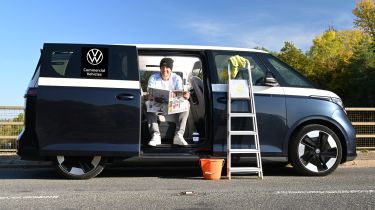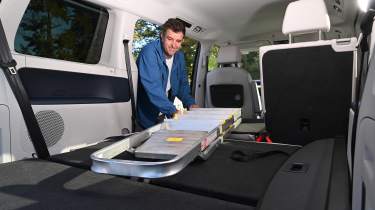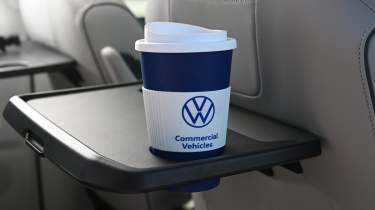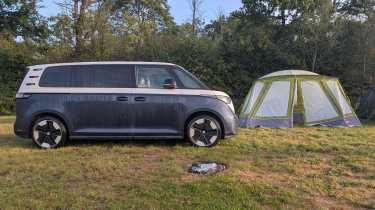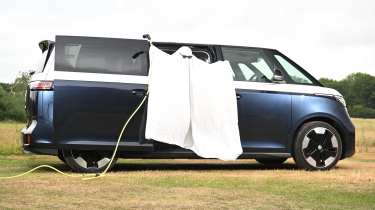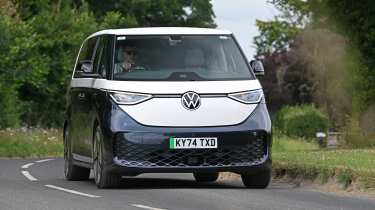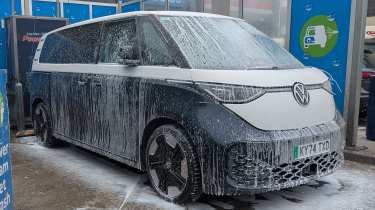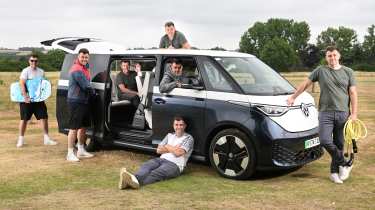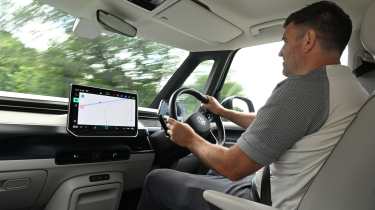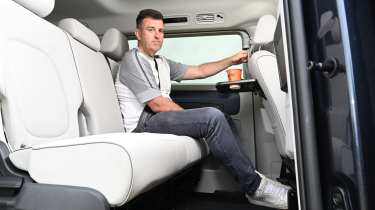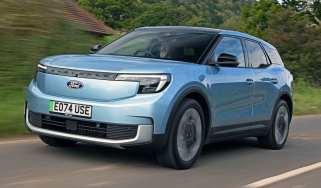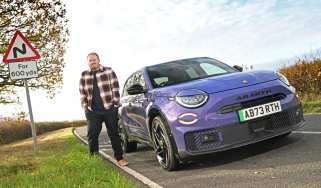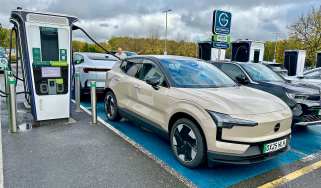Volkswagen ID. Buzz LWB long-term test: It drives like a van, and that’s good
Third report: the van-like driving experience of our ID. Buzz is actually a real plus point, contrary to what some non-van drivers might think

Verdict
The ID. Buzz definitely does drive like a van, but in a good way. Better still, you can get almost as much stuff in it. Add in great visibility, a comfortable ride, surprising agility and those fantastically comfortable seats, and there’s no doubt that the seven-seat version of VW’s electric MPV is winning us over with its charms.
- Efficiency: 2.9 miles/kWh
- Mileage: 7,589 miles
Saying that a passenger car “drives like a van” would probably be seen as a negative by a lot of people, but that would be to ignore two important facts. Firstly, modern vans are much closer to their car cousins than they were years ago. Things have moved on in all kinds of ways – from ride quality and refinement, to performance and technology. Secondly, vans are great to drive anyway!
The VW ID. Buzz drives like a van, which is to say that you’ve got that classic tall driving position (even taller than the ones people can’t seem to get enough of in SUVs), great all-round visibility and a super-tight turning circle for something this large.
You do have to hoist yourself up into the driver’s seat a little but, once you’re there, the upright seating position is easy to get comfortable in, with lots of adjustment and a choice of armrests on which to prop an elbow.
Used - available now

2023 Mazda
CX-5
42,004 milesManualPetrol2.0L
Cash £16,422
2022 Mercedes
CLA Shooting Brake
22,032 milesAutomaticPetrol1.3L
Cash £19,976
2020 BMW
X3
75,000 milesAutomaticDiesel2.0L
Cash £18,897
2022 Nissan
Qashqai
56,674 milesManualPetrol1.3L
Cash £13,697The Comfort Seat Package on the car we’ve been testing is a pretty costly option, but it does retrim all seven of the seats in a flashier fabric and adds heating and massage functions up front. It’s a luxurious place to sit-out a long journey, while getting your back rubbed.
At a whisker under five metres long, the seven-seat ID. Buzz is a big car, but the view you get from the driver’s seat – along with that aforementioned 11.8m turning circle – makes it feel a lot more manageable on the road than many big SUVs with a smaller footprint.
The seating position also gives a good view down the sides of the car and you can even see a fair bit out of the distant rear screen, as long as there’s nobody too tall in the third row. But looking forward, the super-stubby bonnet means you don’t have any visual reference points beyond the base of the windscreen.
This takes some getting used to, but helps to make the VW easier to manoeuvre than you might think to start with – especially because the parking aids in the Buzz err on the side of caution. Even when the bip, bip, beep, beeep, beeeeeep, warning sound becomes a continuous tone, to signal an apparently imminent impact, there’s usually another 30cm of clearance to play with.
It’s also very easy to trigger the automatic emergency braking function at low speeds. Normally, it’s nothing more than a piece of overhanging vegetation that causes the Buzz to slam on its anchors. It can be annoying, but it reinforces the feeling that it would be a hard vehicle to damage in a parking mishap. The exception comes in the form of the £500 21-inch alloy wheels fitted as an option to our car. Their flat surfaces and skinny tyres offer very little protection against kerbs.
Although the electronic safety net around the ID. Buzz has been known to overdo it at low speeds, it’s one of the least intrusive I’ve experienced when you’re going more quickly. The speed-limit warning tone is a faint bong, the Lane Assist intervenes gently at sensible moments, and the Automatic Emergency Braking that’s so trigger happy when parking hardly ever sounds the alarm by coming to the erroneous conclusion you’re about to drive into a roadside object at speed. It’s all very agreeable, to the point I haven’t felt the need to keep turning these systems off and would, crucially, get the benefit from them if a time came when they really were needed.
The ID. Buzz isn’t based on a van platform in the way that a lot of other MPVs are these days, running instead on VW’s ubiquitous MEB electric passenger-car foundations instead. It is offered as a van, however, in the shape of the ID. Buzz Cargo, and there’s a definite commercial vehicle feel to its road manners – polished though they are.
The steering has a well oiled feel and decent accuracy, although I accidentally press the buttons on the central spokes with the palm of my hand on an almost daily basis. As you’d expect, the steering isn’t quick and you have to wind on quite a lot of lock to get around sharp corners, but you’re never encouraged to drive fast enough to make it an issue because of the way the body rolls under cornering. It’s far better to take things easy.
The ride is a little unsophisticated when you encounter bad road surfaces and speed humps, but on smooth roads, it feels well insulated. On the motorway, the suspension is adept at keeping vibrations from the cabin.
There are also no issues with performance. The EV powertrain is ideal for gliding about, adding a strong surge of acceleration when needed. Always a touch inconsistent in pedal feel, the brakes have become slightly squeaky and grabby. They feel strong and progressive when dealing with the VW’s considerable kerbweight of nearly 2.8 tonnes, but I think it would be nice to have a stronger regenerative braking mode because it doesn’t slow the Buzz very quickly or bring it to a halt.
Volkswagen ID. Buzz LWB: second fleetwatch
Our ID. Buzz felt right at home on a late summer camping trip, despite us overloading it with kit
It felt good to a few weeks ago to finally do what you feel a Volkswagen ID. Buzz should be doing. The giant SUV took a late summer camping trip and got back in touch with its Type 2 campervan roots.
If there is a downside to having so much space in your camping car, it’s that there’s a tendency to fill it. Sure enough, the back end was crammed with all kinds of kit and accessories that we probably (certainly) didn’t need, but it was great to have the flexibility.
When opened, the tailgate makes an ideal shelter from the rain, but you have to make sure you’ve got enough space behind to actually get it open. There are 12-volt charging sockets in the boot for keeping phones topped up, even when the car is off. Plus, the dual-height floor with its cubbies below means you’ve always got access to the charge cables, even if the rear is rammed with luggage.
One bugbear is that the Buzz’s roller-blind-type parcel shelf is so wide that there’s nowhere convenient to put it when you need the full boot. We’ve been laying it on the floor under the second row of seats and this works fine, but it looks a bit untidy and passengers have to put their feet on it.
Volkswagen ID. Buzz LWB: second report
Our man has been spooked by some ghostly goings-on in this stylish MPV
- Efficiency: 3.1 miles/kWh
- Mileage: 6,718
Can a car be haunted? I’m not talking about some dilapidated wreck that’s been languishing in the outbuilding of an abandoned stately home for 50 years, hiding the kind of horrifying past that no online history check will ever show up. This is a showroom-fresh Volkswagen ID. Buzz.
You’d think the answer would be ‘no’. And yet, there have been some strange goings on of late. In the dead of night – sometimes in broad daylight, too, but that doesn’t really fit the narrative – the ID. Buzz started opening its own door for no apparent earthly reason.
The passenger-side sliding door was always the culprit. It’s electrically powered, so it can be opened from the key fob or a button inside the car, but it started opening itself at apparently random moments while the car was locked – and always when it was charging.
The door would slide open in its ghostly way, and because the VW was locked, the alarm would go off. This happened infrequently, but usually about once every couple of hours, and it meant that you couldn’t leave the ID. Buzz unattended while it was charging – or have it plugged in overnight – unless you wanted regular alarm calls where you were forced to go outside to close the door and lock the car.
Now, I’ve seen The Exorcist, but rather than a priest, it still felt like the first port of call in this instance should be my local Volkswagen Van Centre (the manufacturer classes the ID. Buzz as a commercial vehicle, so it sells them through its van specialist network).
Sure enough, Eurovans Crawley, West Sussex, identified the issue without rosary beads or vomit – a rogue door latch. The part was placed on order, and two weeks later the mystery was solved, all under warranty.
This little episode led me to consider the sliding doors on the ID. Buzz in a bit more depth than I would otherwise have done. They’re an excellent addition to a vehicle like this, because they create such a wide aperture for getting people and stuff inside. Accessing the third row of seats is a walk-through operation, with none of the clambering you have to do in many seven-seat SUVs.
Unlike the tailgate on the Buzz, which needs a huge amount of space behind the MPV to swing open, the sliding doors can be opened in really tight spaces without the worry of kids damaging adjacent cars that you constantly have with conventional doors. While the doors on our Style model are powered, the entry-level Life versions feature manual ones that you have to slide yourself. Powered doors can be opened from the driver’s seat to let passengers out, or via a press of the key fob button. But if you turn the electric motors off – as I did while trying to solve the door saga – they are very heavy and hard to handle. When opening electrically, they’re also a little slow in operation, sometimes getting confused if you accidentally press the release button twice.
You can save yourself £4,800 by choosing a Life model instead of the mid-range Style version. I’d be very tempted to forgo the automatic doors and tailgate of the Style, but then you also miss out on quite a few other trinkets, including the upgraded ‘Plus’ infotainment system, the LED Matrix headlamps and the 13-speaker Harman Kardon stereo, which really is rather good.
In the end, the ID. Buzz excels as a utility vehicle and pretty much all of that practicality is present in the cheaper Life trim – which makes me feel like that’s the one most buyers would be better off choosing.
Volkswagen ID. Buzz LWB: first fleetwatch
Cleaning the ID. Buzz is proving more difficult than expected
The Volkswagen ID. Buzz is a behemoth of practicality, but not everything about driving a 4,962mm long and 1,985mm wide, 2.7-tonne electric vehicle is a walk in the park. Cleaning it, for example.
There is simply a huge amount of bodywork to wash on the Buzz. The old bucket-and-sponge method is a back-breaking task involving a stepladder to reach the roof, and as soon as you roll into a hand car wash, the staff are reaching for their calculators so they can charge you their inflated rate for ‘extra-large vehicles’. My favourite jet wash doesn’t have a long enough hose on it to reach the far side of the car, so I’ve been using another local one that’s better set-up for vehicles of the larger persuasion.
I do still find myself more motivated to keep the ID. Buzz clean than I have done with other cars, however. Mainly, that’s because so many people seem to enjoy seeing the Volkswagen. The two-tone paint job is a £2,790 option, but it looks so much better than the single-colour options. In Style specification with LED matrix lights and 20-inch wheels, it’s got to be the best-looking ‘van’ out there.
Volkswagen ID. Buzz LWB: first report
For our second long-term test of VW’s retro SUV, we have the new long-wheelbase version. But does bigger mean better?
- Efficiency: 2.9 miles/kWh
- Mileage: 1,196
The more observant among you will have noticed that Volkswagen’s ID. Buzz electric people carrier has already done a stint on our fleet. So why are we testing it again?
The answer is that VW has addressed both of the main criticisms we had of this retro EV by launching a new long-wheelbase model. The ID. Buzz LWB has seven seats and a bigger battery which, in theory, should bring major boosts to both practicality and driving range. The question is, will this be enough to turn the Buzz from lovable fashion statement to first-rate transport for big families? When it originally launched in the UK, the ID. Buzz was available as a five-seater only. It’s extremely practical in that form, but it didn’t quite maximise the car’s potential.
These days you can get the standard version as a six seater, with three rows of seats, for only £150 more than a five-seat model. That seems very reasonable, until you see that the long-wheelbase seven-seater is only another £360. These unusually small gaps make this LWB model look like the pick of the range. The only obvious downside is its extra size.
Prices for the ID. Buzz LWB start at under £60,000 and for that you get a vehicle that’s 4,962mm long – 250mm more than the standard SWB car. The sliding side doors are longer for easier access to a cabin that also has more passenger and luggage space.
The other major upgrade you get with the LWB Buzz models is the battery. The standard model we tested in 2024 had a 77kWh battery that struggled to break the 200-mile range mark in cold weather, although new SWB versions now get an upgraded 79kWh item.
This ID. Buzz LWB has an 86kWh unit and VW’s special 282bhp ‘high-efficiency drive’ electric motor. So far we’ve been getting 2.9 miles per kWh and the indicated range has been consistently over 250 miles. In the midst of the recent heatwave, it showed 281 miles.
Our ID. Buzz is in mid-range Style trim. You can get the all-wheel-drive GTX for another £3,000 or so, but rear-wheel-drive Style seems a good fit unless you really need extra traction.
The options fitted include the Candy White and Starlight Blue two-tone paint job (£2,790). That’s the same price as all the other two-tone paint options, but they do help to accentuate the ID. Buzz’s design and are understandably popular in what is a very style-led car choice.
We’ve also got the Comfort Seat Package (£2,310), which includes adjustable ambient lighting, arm rests, heated, massaging and electrically adjustable front seats, and a more durable carpet. There’s no protective floor mat in the rear, so that carpet upgrade may prove worthwhile, but I’m already worried about the cream-coloured ‘Mistral’ seat fabric that seems likely to show up the dirt.
Finally, there’s a £980 retractable towbar, which we’ve been using for our bike carrier, and the 21-inch Bromberg alloys (£515) thatlook great, but also vulnerable to kerbing. One option missing is the £1,050 heat pump, which would do a lot to boost cold weather range.
It makes a total of £71,615 for our car. That’s a lot, but there aren’t many EV options if you need ID. Buzz levels of space and versatility.
Early impressions are that the VW is a first-class long-distance car. It doesn’t cope well with rough surfaces or corners taken at speed, though, so the message is to keep your passengers happy by taking it easy.
The steering is nicely weighted, the turning circle is tight and the high driving position and parking cameras make it surprisingly easy to manoeuvre, after some familiarisation. You can fit it into most car park spaces, and the sliding side doors mean less worry about kids opening them into parked cars or trolleys.
| Rating | 4.0 stars |
| Model: | Volkswagen ID. Buzz Style 7-seat LWB |
| On fleet since: | May 2025 |
| Price new: | £64,345 |
| Engine: | 1x e-motor, 86kWh battery |
| CO2/tax: | 0g/km/3% |
| Options: | Two-tone paint (£2,790), Comfort Seat Package (£2,310), Retractable towbar (£980), 21-inch Bromberg alloy wheels (£515) |
| Insurance: | Group: 41 Quote: £969 |
| Mileage: | 7,589 |
| Efficiency: | 2.9 miles/kWh |
| Any problems? | Door catch replaced under warranty |
Tell us which new car you’re interested in and get the very best offers from our network of over 5,500 UK dealers to compare. Let’s go…

